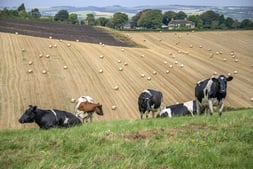As UK agriculture evolves to meet the needs of the public and the environment, many farmers are considering adopting regenerative farming practices to support this movement.
However, it’s important we think carefully about what regenerative agriculture really means for farmers and UK food production.
There are many definitions for regenerative agriculture. For example, Rhodes, 2017 defines regenerative agriculture as an alternative means of producing food that may have lower, or even net positive, environmental and/or social impact.
The IPCC, 2019 state that regenerative agriculture involves sustainable land management practices that are focused on ecological functions effective in building the resilience of agro-ecosystems.
Regenerative farming practices
In summary, regenerative agriculture focuses on specific farming practices that achieve certain outcomes. These practices may include:
- Use of cover crops
- Integration of livestock
- Reducing or eliminating tillage
- Tree planting
- Restoration of habitats
- Minimising the use of inputs
To achieve outcomes such as:
- Improved soil health
- Sequestering carbon
- Increased biodiversity and natural capital
- Improved water health
- Maintaining farm productivity

Despite the growing engagement from the farming community around regenerative agriculture, there is still some uncertainty around what practices need to be adopted to confirm someone is operating a regenerative farming system, alongside, how the outcomes of these practices can be managed, and what success looks like.
Measuring the benefits of regenerative agriculture
Defining and certifying regenerative farming systems and their outcomes is complicated, especially when you consider managing soils, natural capital, integrated pest management, tree health, and all the other things that make up these complex ecosystems.
A number of organisations are having conversations about how regenerative agriculture actions and outcomes can be tracked, to provide greater confidence for more farmers to adopt practices. In time, there may be a set of agreed regenerative farming standards to support uptake.
In the meantime, consideration to understand what regenerative practices could be workable across a farm or estate is needed. The path each business takes to achieve these goals will vary depending on farming systems and locations.
Getting started on this process involves establishing a baseline to understand what biodiversity and natural capital assets are available and how these could be used to support a switch to more regenerative agricultural practices.
As the conversation around regenerative agriculture continue to become mainstream, open, varied discussions need to continue so more farmers see the array of options available to help drive change. It’s through this diversity of approach that the industry will start to evolve to meet the needs of the public and the environment as set out by the government.